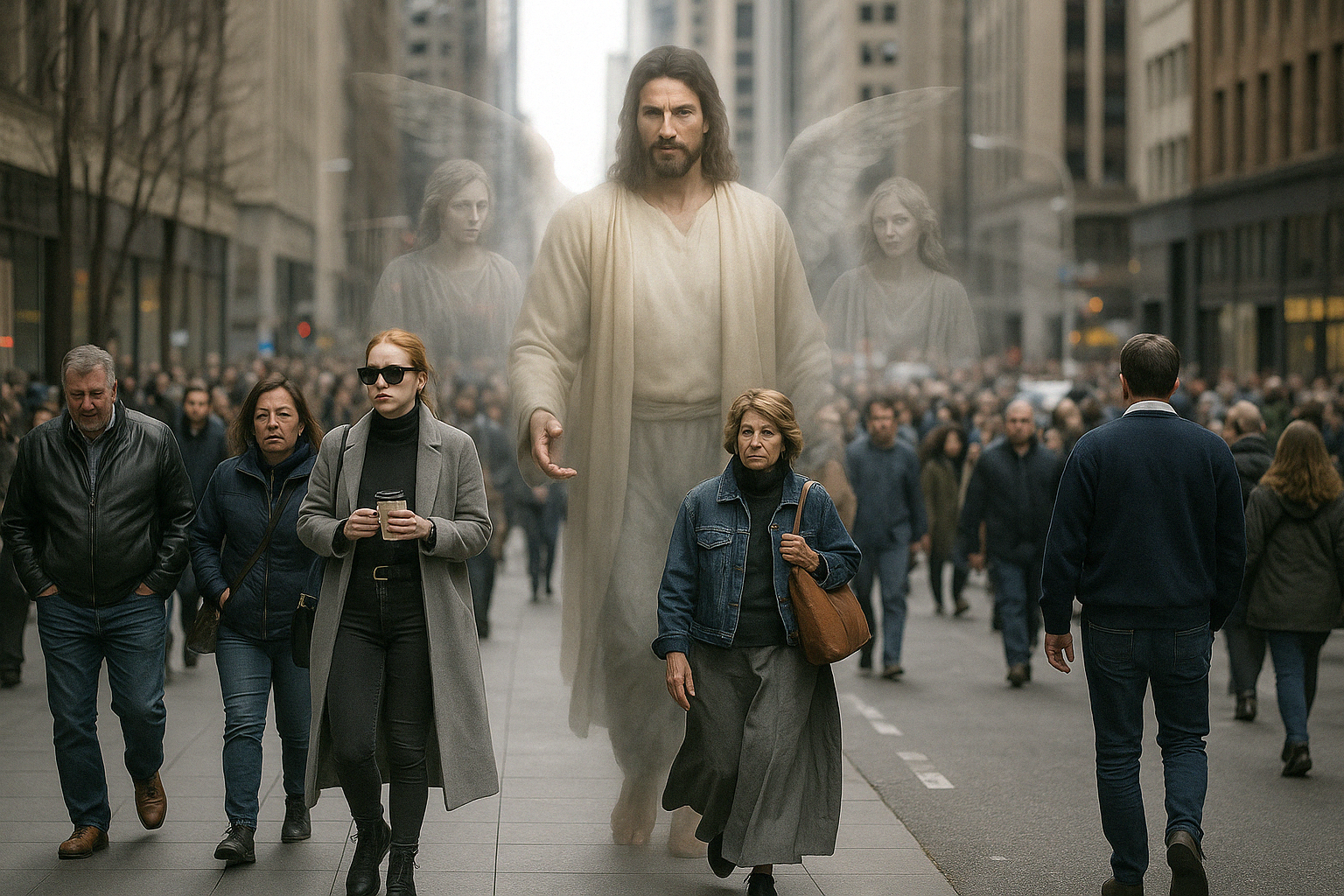The Grammar of Glory and Why It Still Matters
By Dr. Khaldoun A. Sweis
“He is not here, for He is risen, just as He said.”
— Matthew 28:6
✨ The Grammar of Resurrection
Every Easter, Christians around the world greet each other with a phrase that has echoed through the centuries like thunder rolling through a hollow tomb:
“He is risen!”
Not was.
Not has.
But is.
Why this grammatical choice?
The resurrection is not just a past event to commemorate, but a present reality to live in. Jesus didn’t just rise once and fade into history. He is alive—now. And that changes everything.
This phrase is not mere metaphor or memory. It is a theological explosion that breaks through the cement of despair, death, and disbelief.

The resurrection is not merely a quaint belief for the pious but a blasphemous affront to modern cynicism. It is the only heresy left in an age of disbelief. The modern man will believe in aliens, ghosts, quantum immortality, and recycled stardust—but scoffs at a carpenter walking out of a tomb. Why? Because the resurrection, unlike those other myths, has consequences. It demands not just your attention but your allegiance. If the grave could not hold the Author of life, then no part of your own life—your boredom, your brilliance, your brokenness—is truly beyond redemption. The skeptics will say, “Dead men do not rise.” Quite right. And that’s the whole point. This one did. And the world has never been the same—not because men believed in something beautiful, but because something beautifully impossible believed in them, broke into history, and conquered what no army or empire ever could: the finality of death.
🎶 The Resurrection Hymn of the Eastern Church
For centuries, Orthodox Christians have sung the Paschal Troparion, the hymn of resurrection, with defiant joy:
“Christ is risen from the dead,
Trampling down death by death,
And upon those in the tombs
Bestowing life!”
This hymn captures it all:
Christ didn’t just escape death—He crushed it. He used death’s own weapon to destroy it. Like an antidote made from venom, He took in the sting—and gave us the cure.
🧠 But Did It Really Happen?
Let’s not hide behind poetry or pious phrases.
The question that every honest seeker must ask is this:
Did Jesus of Nazareth really, bodily, rise from the dead—or not?
This is not a matter of private religious preference. This is a historical question with eternal consequences.
And here’s the shocker: There is more evidence for the resurrection than most people realize—and far less reason to reject it than you’ve been led to believe.
You have to ask yourself: What kind of event would it take to shatter the natural order and rewrite the human story? We’re not talking about myth or metaphor here. We’re talking about a claim that a man—a real, historical man—died under one of the most brutal regimes in human history, was buried, and then three days later walked out of the grave. If that’s even remotely plausible, then the implications are staggering. It means that death is not final, that meaning is not subjective, and that hope is not delusional. And if it’s true, then you’re no longer the ultimate authority over your own existence. That’s terrifying. That’s why people reject it—not because it’s unreasonable, but because it’s too reasonable. Because if Christ truly rose, then every part of your life—your sin, your suffering, your purpose—is called into question. And perhaps that’s what we fear most: not that God is absent, but that He is dangerously, disruptively, undeniably present.
🚫 The Naturalistic Bias
One of the greatest obstacles to believing in the resurrection is not the lack of evidence—but the bias against miracles.
The argument usually goes like this:
“Miracles can’t happen. Therefore, Jesus didn’t rise from the dead.”
But notice: That’s not an argument. It’s an assumption.
It’s what philosophers call naturalism—the belief that only physical matter exists and that everything must have a natural cause. But this belief is not scientifically proven. It is a worldview, and it must be challenged.
Imagine a man wearing red-tinted glasses and saying, “There is no such thing as the color blue. I’ve never seen it.” You’d say, “You can’t see it because your lens filters it out.”
Likewise, many people wear a lens that filters out the miraculous before they even look at the evidence.
But if there is even a possibility that God exists—then miracles, including the resurrection, are back on the table.
📜 Historical and Manuscript Evidence
Let’s briefly return to the facts.
- Manuscript Reliability: The New Testament has more manuscript evidence than any other ancient text—5,800+ Greek manuscripts, some dated within decades of the original events.
- Eyewitness Testimony: The resurrection accounts come from those who claimed to have seen Him, touched Him, eaten with Him. (1 Cor. 15:3–8)
- Enemy Acknowledgment: Even early Jewish leaders admitted the tomb was empty (Matthew 28:13).
- Radical Transformation: The disciples went from hiding in fear to boldly preaching to their death—all for what they claimed was a true, physical encounter with the risen Christ.
If the resurrection was faked, ask yourself:
What did they gain? Fame? No. Wealth? No. Safety? Certainly not.
They gained beatings, poverty, prison, and martyrdom.
People don’t die for what they know is a lie.
❤️ Why I Believe
I believe Jesus rose from the dead not just because of the evidence—though that matters.
I believe because the resurrection makes sense of the world—and makes sense of me.
Without the resurrection:
- Pain is pointless.
- Love dies with the body.
- Justice is an illusion.
- Your story ends in a grave.
But with the resurrection, the deepest cries of the human heart—for meaning, for love, for justice, for life—are not mocked. They are met.
And not by a religion.
But by a person.
A scarred man who walked out of His tomb and still walks into ours.
🗣️ To the Skeptic (and the Silent Believer)
If you’re reading this and you’ve never believed, I challenge you—not to accept blindly, but to doubt your doubts.
Ask:
- Am I rejecting this because it’s false, or because it’s inconvenient?
- If Jesus really rose, what would that mean for me?
And if you do believe but struggle to talk about it, remember this:
You don’t need to have all the answers. You just need to live in such a way that people ask you the questions.
Sometimes, a simple “Come and see” is all it takes.
Islamic Objections
One of the most significant objections to the crucifixion and resurrection of Jesus comes from Islamic theology, particularly rooted in Surah An-Nisa 4:157, which states: “They did not kill him, nor did they crucify him, but it was made to appear so to them.” Many Muslims interpret this to mean that Jesus was not actually crucified, but that someone else—perhaps Judas or another figure—was made to look like him and died in his place. This view, however, stands in stark contrast to the consensus of historical and textual scholarship. Virtually all New Testament scholars—Christian, agnostic, and even many secular Muslim historians—acknowledge that Jesus of Nazareth was crucified under Pontius Pilate. The crucifixion is one of the most well-attested events in ancient history, verified by multiple independent sources including Tacitus, Josephus, and early non-Christian writings. Moreover, the idea of a substitutionary crucifixion raises profound theological and moral problems: why would God deceive billions of people for over two millennia, allowing them to believe in a death that never occurred? Moreover, the Qur’anic phrase “but it was made to appear so” (shubbiha lahum) is open to various interpretations and has been the subject of intense scholarly debate even within the Islamic tradition. Some early Muslim commentators, including al-Tabari, transmitted traditions that suggested someone else died in Jesus’ place. Others, like Fakhr al-Din al-Razi, acknowledged the confusion and plurality of views in early Islam. The Qur’an does not offer a detailed account of the event, and therefore, it is not unreasonable for Christians to question a late 7th-century text’s denial of an event so thoroughly established six centuries earlier.
Beyond the historical concern, theologically, the idea that God would allow someone else to die in Jesus’ place—thus deceiving all witnesses including his own mother and disciples—raises difficult questions about the nature of divine justice and truth. Christianity proclaims that God is not the author of deception, but the One who enters into suffering and overcomes death not through illusion, but through incarnation and resurrection. The cross is not a symbol of failure but of divine victory over evil, death, and sin.
It must be noted that Christianity does not stand or fall on a claim made centuries after the fact. It stands on the lives of eyewitnesses—men and women who saw Jesus die, buried, and raised again; who did not benefit from the lie but were beaten, imprisoned, and martyred for proclaiming it. No one dies for what they know to be false.
In the spirit of mutual understanding, we invite all truth-seekers—Christian, Muslim, and otherwise—to examine the evidence not merely with the eyes of tradition, but with hearts that long for truth and minds willing to wrestle honestly with the question: What if the cross is not the end, but the beginning? The resurrection, then, must be understood not merely as a doctrinal claim, but as the cornerstone of Christian hope and identity—one that offers historical grounding, existential significance, and a challenge to every worldview that denies the finality of death and the possibility of divine intervention in history. Rather than sidestep the scandal of the cross, Christianity embraces it as the turning point of time, where justice and mercy collided in blood-soaked glory.
📣 Why The Resurrection Still Matters
- It means your worst day is not your last chapter.
- It means the funeral isn’t the end of the story.
- It means evil doesn’t get the final word.
- And it means that God is not far, silent, or imaginary.
He is risen.
Not was.
Not has.
Is.
✨ Final Word
Jesus didn’t rise to start a religion.
He rose to end your separation from God.
The tomb is still empty.
The scars are still visible.
And the invitation is still open:
“Come and see.”
“Touch and believe.”
“Follow Me.”
So whether you’re running from Him, unsure about Him, or longing to return to Him—
He is risen. And that means… you can rise, too.
He is risen.
Not was.
Not has.
Is.
And that means your story isn’t over. In fact, it’s just beginning.




